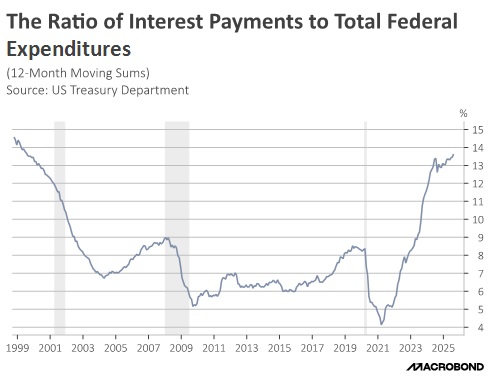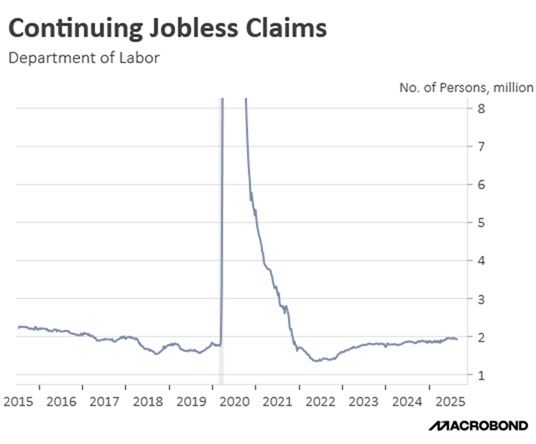by Patrick Fearon-Hernandez, CFA, and Thomas Wash
[Posted: 9:30 AM ET] | PDF
Our Comment today opens with news of a deal between Republicans and Democrats in the Senate that will likely end the federal government shutdown in the coming days. We next review several other international and US developments that could affect the financial markets today, including analysis showing artificial intelligence firms are increasingly using exotic debt instruments to fund their AI infrastructure investments and data showing China has at least temporarily moved out of its recent deflation.
US Fiscal Policy: Eight Democrats in the Senate yesterday struck a deal with Republican leaders and started pushing through a bill that would end the federal government shutdown. Under the deal, the eight Democrats would provide the votes needed for a temporary funding measure lasting until the end of January. In return, the deal would reverse all the layoffs initiated by the White House during the shutdown and guarantee furloughed workers back-pay. However, it only ensures a vote on the Affordable Care Act (ACA) health subsidies that Democrats were holding out for.
- Democrats originally sought to guarantee an extension of the COVID-era ACA subsidies to prevent premiums from surging, but it now looks like they could only get a promise to hold a Senate vote on the matter.
- If the compromise bill passes the Senate, it would go to the House for its approval, which seems likely. Of course, one key risk is that the funding measure only lasts until the end of January, so another shutdown could loom in just two months if legislators can’t come to a long-term agreement on funding the government.
- In any case, the apparent progress toward ending the government shutdown and avoiding more economic damage is giving a boost to US risk assets so far this morning.
US Artificial Intelligence Industry: An important article in the New York Times over the weekend indicates that AI-related companies are increasingly turning to exotic debt instruments to pay for their massive investments in AI infrastructure. The article indicates that while many big, well-known hyperscalers and other firms initially relied largely on their own cash flow to build data centers, they are increasingly issuing asset-backed securities that can be relatively risky and harder for investors to track or analyze.
- As the AI boom proceeds, driving up stock prices for AI-related companies and spurring massive investment in new data centers, models, and other assets, we’ve seen that investors are increasingly asking whether this is a bubble that’s ready to pop.
- One likely indicator of heightened risk would be if today’s capital investment was creating excess capacity and was being financed largely by debt. At the moment, it still appears that the new data centers are being fully utilized, and the use of debt is still not especially high. Nevertheless, we think risks will increase more substantially when and if the boom starts to create unused capacity and starts to rely on large amounts of debt.
US Stock Market: New data from Charles Schwab’s STAX index of customer trading activity shows younger investors, such as those in Gen Z, have become less likely than those in older generations to “buy the dip” when stock prices pull back. The data suggests Gen Z investors have put more of their assets into bitcoin products that are now down for the year, possibly making them more skittish. Where Gen Z investors have been net buyers, they’ve focused on tech firms with solid balance sheets and positive current earnings.
- On Friday, bitcoin prices fell below the psychologically important $100,000 level.
- That means bitcoin has now given up virtually all its gains for the year-to-date.
US Defense Industry: On Friday, Defense Secretary Hegseth laid out several reforms to the Pentagon’s acquisition policies aimed at increasing competition, lowering costs, and speeding weapons development. Importantly, Hegseth said the five main defense contractors would be expected to invest more of their own capital into productive capacity and quicken the pace of innovation. The new policies, which we had been monitoring, help explain why we think foreign defense stocks are likely to outperform their US counterparts going forward.
US Meatpacking Industry: Following a social media post in which President Trump accused big meatpackers of artificially hiking prices, the Justice Department on Saturday said it has opened an investigation into collusion and price fixing among firms including JBS, Cargill, Tyson Foods, and National Beef. The “Big Four” meatpackers collectively slaughter 85% of the country’s cattle and most of its hogs, so the administration’s effort to break up their power and bring down prices could potentially lead to major changes in the industry.
United States-Hungary-Russia: After meeting with Hungarian Prime Minister Orbán at the White House on Friday, President Trump has granted Hungary a one-year extension on his sanctions targeting countries that buy Russian oil. Orbán also agreed to have Hungary buy about $600 million of liquified natural gas from the US. In any case, the sanctions exemption provides a bit of relief for Russia and somewhat reduces the impact of the new sanctions on the global oil market.
Chinese Economy: The October consumer price index (CPI) was unexpectedly up 0.2% from the same month one year earlier, just bringing the country out of deflation. Excluding the volatile food and energy components, the October core CPI was up 1.2%. The exit from deflation has given a boost to Chinese stocks today, although it’s still not clear if prices will continue to rise going forward.
- Other data today showed Chinese producer prices are still under pressure from the country’s housing glut, weak consumer demand, and excess industrial capacity.
- The October producer price index was down 2.1% year-over-year, for its 37th straight month of contraction.
Chinese Military: In a ceremony on Friday, the Chinese military commissioned the Fujian, the country’s third aircraft carrier overall and its second domestically produced carrier. The vessel incorporates several advanced technologies, such as electromagnetic catapults that allow it to launch a greater variety of aircraft at a quicker pace. That should boost China’s ability to keep the US Navy at bay in case of a conflict in the Western Pacific Ocean. However, the ship doesn’t have nuclear propulsion like US carriers do, so its ability to project power is somewhat limited.
Japan-Taiwan-China: In a parliamentary debate on how Japan should respond to a potential Chinese effort to seize control of Taiwan by force, Japanese Prime Minister Takaichi on Friday said, “If battleships are used and a naval blockade involves the use of force, I believe that would, by any measure, constitute a situation that could be deemed a threat to Japan’s survival,” implying she would order the Japanese military to get involved.
- Takaichi today tried to soften the controversial statement, saying she hasn’t changed Japan’s defense policy.
- Nevertheless, the statement has sparked controversy in Japan, underlining Takaichi’s reputation as an anti-China hawk.








